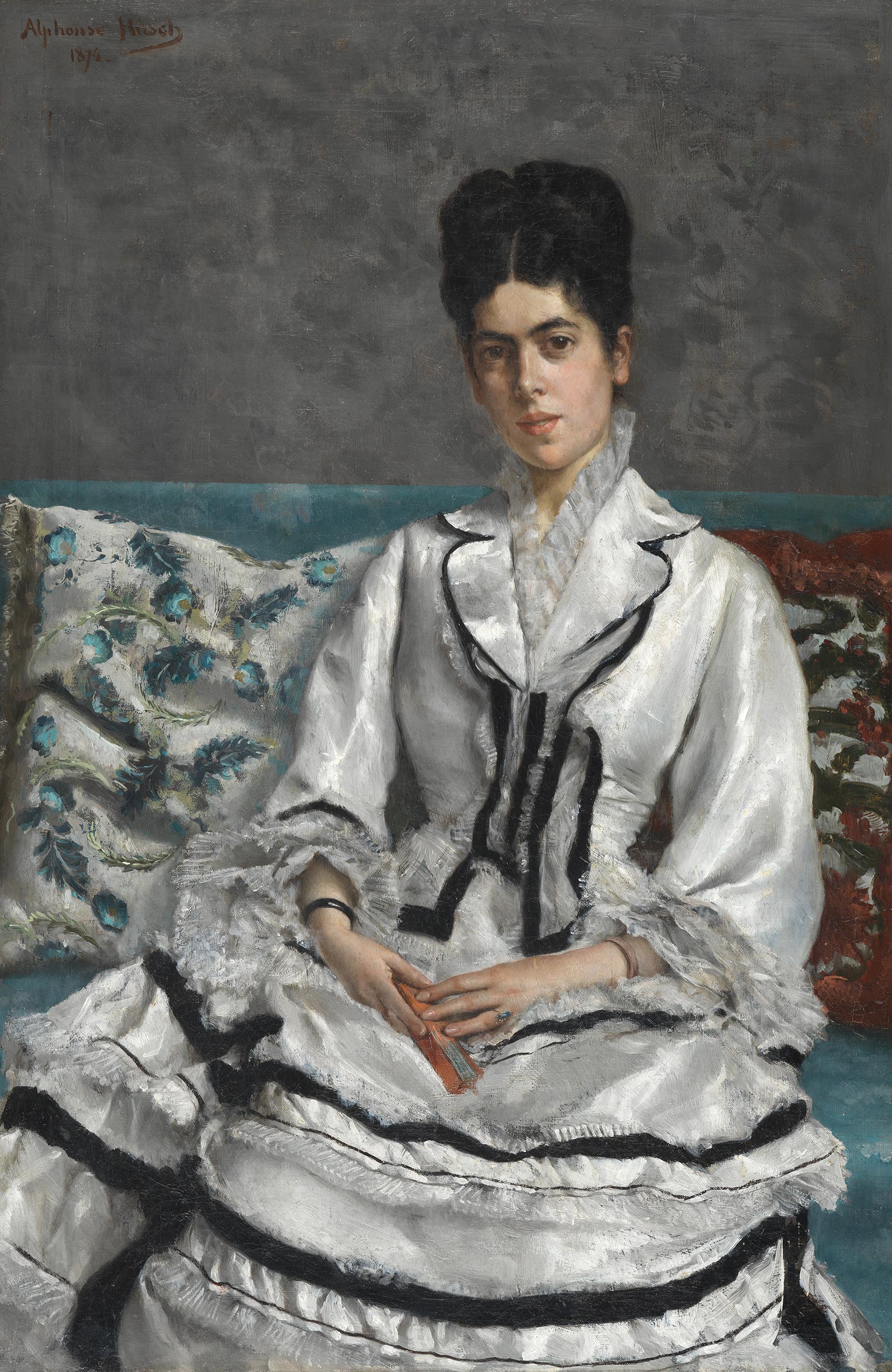
Hirsch
Alphonse
Paris 1843 — 1884
Portrait of a Woman Holding a Closed Fan
Oil on canvas.
Signed and dated Alphonse Hirsch 1874 upper left.
Previous underlying painting visible around the edges.
56 x 38 cm (22 x 14 15/16 in.)
Wearing a white dress trimmed with black, this young brunette woman from the Parisian haute bourgeoisie of the early Third Republic is seated on a blue-grey sofa furnished with peacock feather patterned cushions. Her gaze is open and direct and her hands rest on her legs holding a closed fan. The portrait is a highly refined example of the painter’s talent through its subtle use of a cool palette – blues and greys – enhanced by small flicks of red on the cushion.
A painter and engraver who was close to the Impressionists, Alphonse Hirsch is no longer well known today. However, according to one of his earliest biographers, “No Parisian had more connections than this one.1” Born into a family of four children who lost their father at an early age and were brought up by their mother, Hirsch initially worked in finance. At the age of 24, like his brother Émile, a stained-glass painter, he decided to devote himself to art and began his training by copying old masters at the Louvre. He studied engraving with François Flameng (1865-1923) and painting with Léon Bonnat and Ernest Meissonier. He began his career as an interpretive engraver debuting in the 1869 Salon, but the following year exhibited an oil painting and quickly specialised in genre scenes and portraits.
During the 1870 war, Hirsch enlisted and became a munitions officer at the Hôtel de Ville, then a lieutenant in the National Guard. At the end of the siege, he was mobilised by the Commune. A close friend of painters such as Édouard Manet, Edgar Degas, Marcellin Desboutins and Giuseppe de Nittis; the writers Alphonse Daudet and Edmond de Goncourt, and musicians including Jules Massenet and Charles Gounod, he was well-connected in Parisian high society. His famous portrait of the Camondo family children in their winter garden (Fig. 1), executed the year after our painting, bears witness to this. Manet painted several of his works in Hirsch’s studio garden, situated on the banks of the western railway line and just behind his own atelier at 58 rue de Rome. Among them is Le Chemin de fer (The Railway, National Gallery of Art, Washington), in which Victorine Meurent and Hirsch’s daughter are posed (Fig. 2). It was Hirsch who introduced the famous courtesan Mery Laurent to Manet, who later drew an allegorical pastel portrait of her known as L’Automne or Méry Laurent au chapeau noir (Autumn or Méry Laurent in a Black Hat, Musée des Beaux-arts, Dijon).
Hirsch was also a collector and owned many engravings by Charles Meryon and Félix Bracquemond. A great lover of Japanese art, he was one of the founding members of the Jing- Lar Society, which brought together Zacharie Astruc, Philippe Burty, Henry Fantin Latour, Félix Bracquemond and Marc-Louis Solon, the director of the Sèvres porcelain factory, through their passion for Japanese art2. Hirsch’s collection seems to have drawn the admiration of his contemporaries, particularly Louis Gonse3. However, there was no public sale organised after his death and the objects are now untraceable.
In painting, Hirsch began by exhibiting scenes of interiors at the Salon in the early 1870s, of which few have resurfaced4. It was Léon Bonnat who advised him to take up portraiture. He painted portraits of personalities such as the writer Octave Feuillet (Musée d’Art et d’Histoire, Saint-Lô) and Isidor, the Chief Rabbi of France5. He produced a large number of small portraits similar to our own, but also those of Siegfried Bing6 (from whom he regularly bought Japanese art) and Ernest Daudet. He received regular critical acclaim, but died at the age of 41 and was quickly forgotten. Among the many works listed in the Salon booklets and described by commentators of the time, few have survived or been identified with any certainty. Dated 1874, our portrait is one of the very first painted by the artist and the talent it demonstrates could only have encouraged Léon Bonnat to push him in this direction. “In the portrait, he achieved a perfect likeness, with clarity of tone and boldness of brushwork that brought him closer to both the old masters and the innovators,” Charles Frank rightly commented7. In our work, the hands are painted with a precise, meticulous, almost photographic realism, while the shimmer of the dress is treated with broad, free, modern brushstrokes, intended to be seen with a little distance so that the image takes shape, reminiscent of Manet’s work.
- Albert Wolff, Le Figaro, 18th July, 1884.
- Exhibition Le Japonisme, Grand Palais 17th May-15th August, 1988, catalogue Paris RMN, 1988, p. 80.
- Louis Gonse, “Collection de Alphonse Hirsch”, Catalogue de l’exposition rétrospective de l’Art japonais organisé par Louis Gonse, Paris, A. Quantin, April, 1883, p. 373-395, n° 1-176.
- En visite, exhibited in the 1875 Salon is known by its reproduction in L’Univers illustré of 1875, in a photograph by M. Goupil.
- Known through its reproduction in L’Univers Illustré of 1877, the paintin is commented on and described in Revue des deux mondes, 1877, Tome 21, p. 836.
- Exhibited in 1878, see exhibition booklet: Cercle artistique et littéraire, Exposition de peintures et de sculptures de 1878, Paris, printed by Paul Dupont, p.18, n°120.
- Charles Frank, “Alphonse Hirsch”, L’univers illustré, 26th July, 1884, p. 474.

